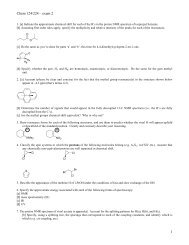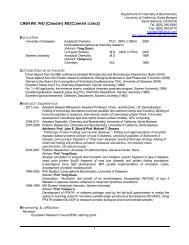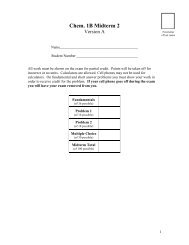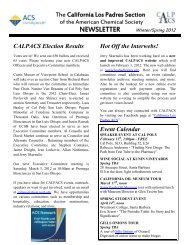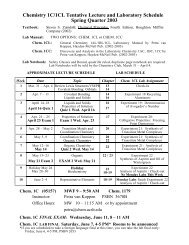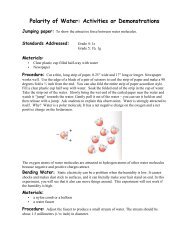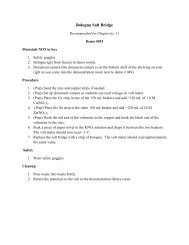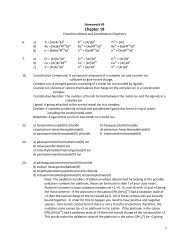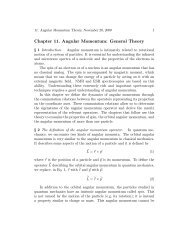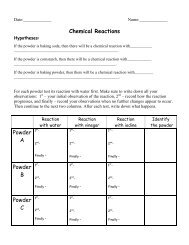Writing Science Lab Reports - California K-12 Science Outreach
Writing Science Lab Reports - California K-12 Science Outreach
Writing Science Lab Reports - California K-12 Science Outreach
Create successful ePaper yourself
Turn your PDF publications into a flip-book with our unique Google optimized e-Paper software.
<strong>Writing</strong> <strong>Science</strong> <strong>Lab</strong> <strong>Reports</strong><br />
Integrating Language Arts,<br />
English Language Development<br />
& <strong>Science</strong><br />
• Prepare Students to Write <strong>Science</strong> <strong>Lab</strong>s<br />
• Motivate Students to Write<br />
• Quick and Easy Grading Rubric<br />
Integrating Content to Increase Learning for all<br />
Students – including English Learners -<br />
and<br />
Maximize Teaching Efficiency<br />
Nancy Escamilla<br />
E.P. Foster Elementary School<br />
Nancy.Escamilla@venturausd.org<br />
ghmnme@aol.com<br />
August 2007<br />
1
Integrating Content to Increase Learning and Maximize<br />
Teaching Efficiency<br />
As a 5 th grade bilingual elementary teacher, I struggled with doing hands-on<br />
science experiments and accurately assessing what my students had learned and what was<br />
still unclear. I found that multiple choice questions did not always give me a clear picture<br />
of what they understood. On the other hand, reading their written responses gave me a<br />
better idea, but reading all the journals and deciding how to grade them seemed to be a<br />
monumental task. In addition, noting their errors and conferencing one on one was<br />
impossible if I wanted to teach the rest of the 5 th grade curriculum. Even so I continued<br />
doing hands-on science activities trying my best to fit everything in. I did this from 2003-<br />
2006 while taking advantage of numerous professional development opportunities, some<br />
of which included A Focused Approach to English Language Instruction, Adept,<br />
Sheltered Instruction Observation Protocol (SIOP), The Write Institute, and The South<br />
Coast <strong>Science</strong> Project. With the knowledge gained through this professional<br />
development and from analyzing my students’ work, I have designed a formal assessment<br />
for the science concepts I taught along with an assessment of my students’ level of<br />
academic written language, which I implemented and improved in 2006-2007.<br />
Meeting the Challenge<br />
• Teach a step by step process to writing a science lab report<br />
• Keep students motivated to write<br />
• Include drawing a diagram or sketch of the lab<br />
In order to improve the integration of Language Arts and English Language<br />
Development with <strong>Science</strong>, students should be taught a step by step process to writing a<br />
science lab. If the teacher requires the students to first write the science standard or<br />
standards that relate to the lab, the hypothesis, the materials and the procedures before<br />
doing the lab work, the students will be more motivated to write. Finally, since most<br />
students enjoy drawing, students should also be required to first write their results and<br />
conclusion before being allowed to draw the results of the lab.<br />
Learning to Listen to Academic Information<br />
• Introduce academic listening activities<br />
‣ Video quiz<br />
‣ <strong>Science</strong> vocabulary bingo<br />
‣ <strong>Science</strong> songs<br />
At the beginning of the year, it is important to help students learn how to focus<br />
and listen carefully to the information presented. One way to do this is to give them a<br />
video quiz before watching the video. Language learners are given extra time to look up<br />
all the vocabulary needed to understand all the questions on the quiz while other students<br />
complete a math worksheet or some other assignment that language learners can<br />
2
complete at home. When the students take the quiz, they mark their answers with a light<br />
pencil mark. As they watch the video, they are required to correct their answers before<br />
turning in the quiz for a final grade. Another way to improve listening skills is to play<br />
bingo. Students are given definitions of science vocabulary and then asked to match the<br />
vocabulary to the definition. Once they have finished this activity, the teacher says the<br />
definition as the students fill in their science vocabulary bingo card. Finally, a fun way to<br />
improve listening skills and to have students repeat science concepts is through science<br />
songs. Before playing the song, give the lyrics as a cloze exercise with key words<br />
missing.<br />
Doing the Activity<br />
• Build background information<br />
• Demonstrate experimental set-up<br />
• Provide an interesting question that students will be able to test<br />
• Students write the standard, hypothesis, materials, and procedure<br />
• Make expected behavior clear<br />
• Self-monitor positive classroom behavior<br />
• Require that students ask a neighbor for help before they ask the teacher<br />
• Have students work in pairs<br />
• All students do the activity at the same time, to experience the<br />
excitement of discovering what will happen for themselves<br />
• Students write their results and conclusions before they draw the<br />
results of the lab<br />
In preparation for the lab, the teacher presents the background information<br />
through a variety of methods, such as textbook or article, science song, PowerPoint,<br />
demonstration of a model and/or video. She/he then demonstrates the experimental set-up<br />
and provides an interesting question that students will be able to test. Before students do<br />
the activity they are asked to write the standards that relate to the lab, write the procedure,<br />
the materials, and the hypothesis. Students should also be taught the expected behavior<br />
requirements with extremely structured labs that require studying, reading, discussions<br />
and writing before they are allowed to start the investigation. Once students learn the<br />
expected behavior, they can have more freedom to do the investigations on their own<br />
with minimal teacher intervention. Positive student behavior and attitudes are encouraged<br />
through scientific inquiry. Students learn that they need to be responsible in order to be<br />
trusted to use the materials required in a scientific investigation. In addition, students are<br />
rewarded with extra science labs when homework in other areas is done consistently and<br />
diligently. Since students understand that the teacher has extra preparation work to set up<br />
science labs and worksheets and that she does not have time to deal with misbehavior,<br />
students monitor and encourage each other to behave appropriately. Students learn that<br />
participation in a hands-on science lab is a privilege not a requirement.<br />
3
Essential Academic Vocabulary Development<br />
• Pre-teach vocabulary<br />
• Use traditional methods of teaching vocabulary<br />
• Introduce Academic Vocabulary Organizer for abstract terms<br />
Vocabulary is pre-taught using traditional methods: word walls, dictionary skills,<br />
word bingo, word analysis, etc. In addition to these methods, students use an Academic<br />
Vocabulary Organizer to learn how to use academic vocabulary words that are abstract.<br />
In accordance with a student’s English level or expertise in writing, some worksheets are<br />
partly filled in for students needing extra support, while other students receive the generic<br />
version to be completely filled out.<br />
Reaching Written Academic Fluency<br />
• Use writing rubric as a reference<br />
• Review sentence frames from previous labs<br />
• Explain language requirements for written work<br />
• Post example lab write-ups from previous labs in the classroom<br />
• Students plan and implement investigative procedures<br />
Students learn to refer to a <strong>Science</strong> <strong>Lab</strong> <strong>Writing</strong> Rubric to write their science lab.<br />
Each part of the rubric should be introduced with a new lab. For example, the sentence<br />
frame for drawing conclusions can be introduced when it corresponds with what is being<br />
taught in the Language Arts curriculum. Transition words for writing the procedure of the<br />
lab is introduced at the same time that the imperative verb form and reading instructions<br />
is being taught in Language Arts. Finally, the sentence frame for writing a basic<br />
hypothesis may be taught in several labs because it requires a complex sentence structure<br />
and previous science background.<br />
In the first labs, the teacher models the different parts of a science lab write-up,<br />
only focusing and grading one part of the lab. The teacher can decide what part or parts<br />
of a lab she wants students to write independently and what part she wants to continue to<br />
model. Finally, after several labs have been completed, students can review the<br />
hypotheses and the standards that have been covered by doing a worksheet that requires<br />
them to match the correct dependent clause to the correct independent clause. This<br />
worksheet can also be used as a basis for creating a PowerPoint presentation or a class<br />
book of the labs already studied. The goal of the PowerPoint presentation is not only to<br />
review the standards, but also to review the dependent and independent clauses that make<br />
up a basic hypothesis and a conclusion.<br />
The final goal is to have students plan and implement investigative procedures by<br />
returning to previous labs or to new labs to reinforce concepts already taught and to<br />
introduce how to change or improve a lab. The basic hypotheses that have been<br />
developed throughout the year can be used to introduce the concept of variables and how<br />
variables can be used to change an experiment and a hypothesis.<br />
4
Forming Student Pairs & Rotating Partners using a Meeting Clock<br />
(This needs to be in the Student <strong>Lab</strong> Notebook to be used as a reference)<br />
Date: ______________<br />
<strong>12</strong><br />
9<br />
3<br />
6<br />
Forming Clock Partners<br />
‣ Students write the names of their partners in the <strong>12</strong>, 3, 6 and 9 o’clock positions<br />
‣ Having clock partners saves time, avoids confusion, keeps a record of partners<br />
‣ If a partner problem arises, move a student (this requires surrounding students<br />
to make a new clock in notebook with a new date)<br />
Partner Activities<br />
‣ Students discuss vocabulary, concepts, questions<br />
‣ Students work together to do science labs or any other activities<br />
5
Word Analysis (Teacher Information)<br />
Absorb: To take up by capillary action or chemical action. A liquid or solid material can<br />
absorb particles of gas or liquid. For example, a sponge absorbs water.<br />
Attraction: (attract) The ability to make things move toward each other.<br />
Chromatogram: The visual output that results from performing chromatography. In the<br />
activities today the pieces of paper with splotches and streaks of colors are your<br />
chromatograms.<br />
Chromatography: A technique used to separate mixtures into their individual components.<br />
Interaction: (interact) The effect that two or more things have on each other.<br />
Transportation: (transport) The process of moving things from one place to another.<br />
Observation: (observe) The act or process of carefully watching someone or something.<br />
Prefix – (meaning) Base/Root – (meaning) Suffix – (part of speech)<br />
ab +<br />
(away from, off)<br />
____sorb<br />
(draw into)<br />
+ tion<br />
(noun)<br />
a +<br />
(toward)<br />
+ tract<br />
(to pull)<br />
+ tion<br />
(noun)<br />
chroma +<br />
(color)<br />
_____ gram<br />
(something written or<br />
drawn, a record of)<br />
inter +<br />
(between)<br />
trans +<br />
(across)<br />
ob +<br />
(toward)<br />
________ graph<br />
(something written or<br />
drawn)<br />
_____act _____<br />
(to behave in a particular<br />
way)<br />
_____ port ____<br />
(carry)<br />
_____ serve _____<br />
(keep, save)<br />
+ y<br />
(noun meaning ‘study of’)<br />
+ tion<br />
(noun)<br />
+ tion<br />
(noun)<br />
+ er<br />
(noun person)<br />
+ tion<br />
(noun)<br />
+ er<br />
(noun person)<br />
Online resources:<br />
http://ueno.cool.ne.jp/let/prefix.html<br />
http://www.southampton.liu.edu/academic/pau/course/webesl.htm<br />
http://www.msu.edu/~defores1/gre/roots/gre_rts_afx1.htm<br />
http://sps.k<strong>12</strong>.ar.us/massengale/prefix__suffix_list.htm<br />
http://www.lausd.k<strong>12</strong>.ca.us/lausd/resources/verbal.clues.with.latin/latinmainmenu.html<br />
6
Word Analysis (Student Worksheet)<br />
Place the word parts of the following words in the table below:<br />
Name:_________________<br />
Date:_________________<br />
absorption absorb attraction chromatogram chromatography<br />
interaction transportation transporter observation observer<br />
Prefix – (meaning) Base/Root – (meaning) Suffix – (part of speech)<br />
7
Life <strong>Science</strong> Vocabulary<br />
(Student Worksheet to Learn Vocabulary)<br />
**Vocabulary**<br />
Definitions<br />
– blood vessels that carry blood away from the heart<br />
– the basic unit of life<br />
– what cells need to do work<br />
– a gas that living organisms exhale<br />
– microscopic blood vessels that exchange nutrients and<br />
waste<br />
– the movement of blood around the body<br />
– organism that feeds on other organisms for food<br />
– the process by which many materials go in and out of cells<br />
– the tube from your mouth to your stomach<br />
– enclosed space in the heart<br />
– organism that feeds or obtains nutrients by breaking down<br />
organic matter<br />
– the gas we breathe in<br />
– organism that makes its own food from the environment;<br />
usually a green plant<br />
– plants and animal cells break down sugar to obtain energy,<br />
a process resulting in carbon dioxide and water<br />
– a type of solid, liquid or gas that has particular qualities<br />
– organs that work together<br />
– the tube that takes air from your throat to your lungs<br />
– to carry or move from one place to another<br />
– blood vessels that carry blood to the heart<br />
– the nutrient that cells use for energy<br />
‣ Teacher reads vocabulary words off the Bingo check list out of order (words are<br />
given on the next page).<br />
‣ Students play Bingo once they are familiar with the words.<br />
8
Life <strong>Science</strong> - Bingo Checklist<br />
1 st<br />
game<br />
2 nd 3 rd 4 th Arteries – blood vessels that carry blood away from the heart<br />
Capillaries – microscopic blood vessels that exchange<br />
nutrients and waste<br />
Carbon dioxide – a gas that living organisms exhale<br />
Cell – the basic unit of life<br />
Circulation – the movement of blood around the body<br />
Composer - organism that feeds on other organisms for food<br />
Decomposer - organism that feeds or obtains nutrients by<br />
breaking down organic matter<br />
Diffusion – the process by which many materials go in and out<br />
of cells<br />
Energy – what cells need to do work<br />
Esophagus – the tube from your mouth to your stomach<br />
Heart chamber – enclosed space in the heart<br />
Oxygen – the gas we breathe in<br />
Producer - organism that makes its own food from the<br />
environment; usually a green plant<br />
Respiration – plants and animal cells break down sugar to<br />
obtain energy, a process resulting in carbon dioxide and water<br />
Substance – a type of solid, liquid or gas that has particular<br />
qualities<br />
Sugar – the nutrient that cells use for energy<br />
System – organs that work together<br />
Trachea – the tube that takes air from your throat to your lungs<br />
Transport – to carry or move from one place to another<br />
Veins – blood vessels that carry blood to the heart<br />
9
Bingo Game Board<br />
(This needs to be in the Student <strong>Lab</strong> Notebook to be used to review vocabulary in a week or two)<br />
‣ Students write the vocabulary words from list anywhere on the page<br />
‣ The teacher reads definitions<br />
‣ Students use chips to cover up answers (the vocabulary word that correspond to<br />
the definitions)<br />
‣ When a student claims to have “Bingo”, the student reads off the words and the<br />
teacher reviews the Bingo check list to see if the definitions for these words were<br />
given<br />
‣ Students re-use Bingo game board for vocabulary review<br />
10
<strong>Science</strong> Standards<br />
Students are provided with a copy of their grade level science standards so they can look up the<br />
standards that they will learn about for a given science activity. Students write the standards as<br />
part of the lab report before they do the activity.<br />
For example, consider the inquiry based Air Pressure Activity presented by Kim Castagna.<br />
Air Pressure Activity<br />
‣ Fill a plastic cup partway with water.<br />
‣ Place an index card across the top of the cup<br />
‣ Ask the class to predict what would happen if I were to turn the cup over and let go<br />
of the card.<br />
‣ After students write the standard, the hypothesis, the materials and the procedure in their<br />
lab report, they go outside to do the activity<br />
‣ Students should refer back to the standard for an explanation of what happened.<br />
‣ After students have written their conclusion and turned in their lab reports, discuss the<br />
results with the class.<br />
[The card adheres to the cup and the water doesn’t pour out – this is because the card slightly<br />
bulges downward, decreasing the air pressure inside the cup. The outside pressure is higher,<br />
and sufficient to keep the card in place]<br />
CALIFORNIA CONTENT STANDARDS: Grade 5<br />
http://www.cde.ca.gov/ta/tg/sr/blueprints.asp<br />
# of<br />
Items<br />
%<br />
Earth <strong>Science</strong>s 18 30%<br />
Earth <strong>Science</strong> – Grade 5 11<br />
3. Water on Earth moves between the oceans and land through the<br />
processes of evaporation and condensation. As a basis for<br />
understanding this concept:<br />
a. Students know most of Earth's water is present as salt water in the<br />
0 or 1**<br />
oceans, which cover most of Earth's surface.<br />
b. Students know when liquid water evaporates, it turns into water vapor in<br />
the air and can reappear as a liquid when cooled or as a solid if cooled 1<br />
below the freezing point of water.<br />
c. Students know water vapor in the air moves from one place to another and<br />
can form fog or clouds, which are tiny droplets of water or ice, and can fall 1<br />
to Earth as rain, hail, sleet, or snow.<br />
d. Students know that the amount of fresh water located in rivers, lakes,<br />
underground sources, and glaciers is limited and that its availability can 1<br />
be extended by recycling and decreasing the use of water.<br />
e. Students know the origin of the water used by their local communities. N/A*<br />
* Not assessable on a statewide examination.<br />
** Alternate years<br />
11
CALIFORNIA CONTENT STANDARDS: Grade 5<br />
# of<br />
Items<br />
%<br />
4. Energy from the Sun heats Earth unevenly, causing air movements<br />
that result in changing weather patterns. As a basis for<br />
understanding this concept:<br />
a. Students know uneven heating of Earth causes air movements<br />
1<br />
(convection currents).<br />
b. Students know the influence that the ocean has on the weather and the<br />
1<br />
role that the water cycle plays in weather patterns.<br />
c. Students know the causes and effects of different types of severe<br />
1<br />
weather.<br />
d. Students know how to use weather maps and data to predict local<br />
1<br />
weather and know that weather forecasts depend on many variables.<br />
e. Students know that the Earth's atmosphere exerts a pressure that<br />
decreases with distance above Earth's surface and that at any point it 1<br />
exerts this pressure equally in all directions.<br />
5. The solar system consists of planets and other bodies that orbit the<br />
Sun in predictable paths. As a basis for understanding this concept:<br />
a. Students know the Sun, an average star, is the central and largest body in<br />
0 or 1**<br />
the solar system and is composed primarily of hydrogen and helium.<br />
b. Students know the solar system includes the planet Earth, the Moon, the<br />
Sun, eight other planets and their satellites, and smaller objects, such as 1<br />
asteroids and comets.<br />
c. Students know the path of a planet around the Sun is due to the<br />
1<br />
gravitational attraction between the Sun and the planet.<br />
Earth <strong>Science</strong> – Grade 4 7<br />
4. The properties of rocks and minerals reflect the processes that<br />
formed them. As a basis for understanding this concept:<br />
a. Students know how to differentiate among igneous, sedimentary, and<br />
metamorphic rocks by referring to their properties and methods of<br />
1<br />
formation (the rock cycle).<br />
b. Students know how to identify common rock-forming minerals (including<br />
quartz, calcite, feldspar, mica, and hornblende) and ore minerals by using 1<br />
a table of diagnostic properties.<br />
5. Waves, wind, water, and ice shape and reshape Earth's land surface.<br />
As a basis for understanding this concept:<br />
a. Students know some changes in the earth are due to slow processes,<br />
such as erosion, and some changes are due to rapid processes, such as 2<br />
landslides, volcanic eruptions, and earthquakes.<br />
b. Students know natural processes, including freezing and thawing and the<br />
1<br />
growth of roots, cause rocks to break down into smaller pieces.<br />
c. Students know moving water erodes landforms, reshaping the land by<br />
taking it away from some places and depositing it as pebbles, sand, silt, 2<br />
and mud in other places (weathering, transport, and deposition).<br />
* Not assessable on a statewide examination.<br />
** Alternate years<br />
<strong>12</strong>
Request (Language Development)<br />
‣ Hand out a copy of a page in a book or text consisting of at least two or more paragraphs<br />
Note: Teacher provides appropriate level text for English learners (for example,<br />
use 2 nd or 3 rd grade level text for a 4 th or 5 th grade EL student).<br />
‣ Students work with a partner<br />
‣ Students select and read a paragraph.<br />
‣ One student closes the book and the other student asks questions relating to the<br />
paragraph.<br />
To avoid yes/no answers: On the board write the question format students use.<br />
Question format: Questions start with what, where, how, when, or why<br />
‣ Students select a new paragraph and switch roles to ask and answer questions<br />
‣ Teacher circulates to listen to questions and answers<br />
‣ When students say they are finished, they write one or more of their questions and<br />
answers in their lab notebook.<br />
‣ Student is informed that their grade is determined from how well they write the questions<br />
and answer.<br />
‣ Remind students that they should not misspell any words that are found in the paragraphs<br />
they have just read. They are to refer to the book they were reading from to help them<br />
write their questions and answers.<br />
Example Text:<br />
13
Sentence Frames<br />
Purpose: <strong>Writing</strong> prompts are used to focus a student’s thinking. Students use sentence<br />
frames to organize their ideas, prompt their thinking, and structure their written response.<br />
Frames help students become more proficient in scientific writing and less reliant upon the<br />
prompts. Reference for purpose: www.sciencenotebooks.org<br />
Testable Statement/Hypothesis:<br />
If water molecules are polar, then they will attract.<br />
If_____________________________, then<br />
__________________.<br />
______________________________will<br />
The more mentos used, the higher, stronger, and explosive the coke will shoot out of the<br />
bottle.<br />
The comparative adjective + variable + verb, comparative adjectives + what is being<br />
tested.<br />
If the amount of gas yeast produces is related to the amount of sugar, then the more sugar<br />
added to yeast the more CO2 will be produced.<br />
If + dependent variable is related to independent variable, then ________________ will<br />
_____________ .<br />
Results:<br />
After _____________________________________, I smelled_________________.<br />
Once I __________________________, ______________ felt_________________.<br />
The following day__________________________, I observed_________________ .<br />
My results show___________________________________ .<br />
Conclusion:<br />
When ___________________________________, I understood that<br />
_______________________________________________________ .<br />
Since __________________________________________, I can infer/ conclude that<br />
________________________________________.<br />
Based on the fact that ______________________________, I can infer/conclude that<br />
________________________________________.<br />
Nancy Escamilla 2007<br />
14
Review of Dependent and Independent Clause<br />
Sentence Structure for a Basic Hypothesis<br />
Match the dependent clause to the correct independent clause and write the<br />
complete sentence on a separate sheet of paper.<br />
1. If saltwater is denser than an egg, then it will react with iodine and vinegar.<br />
2. If carbon dioxide is denser than air, then it will float to the top.<br />
3. If this mineral is magnetite, then it will react with iodine by turning<br />
purple.<br />
4. If air pressure is pushing all around us, then a magnet placed in it will attract the<br />
iron bits.<br />
5. If sand or dirt has bits of iron in it, then it will react with vinegar.<br />
6. If powder A is baking soda, then a magnet will be attracted to it.<br />
7. If powder B is cornstarch, then it can be poured<br />
8. If powder C is baking powder, then the egg will float.<br />
9. If oil is less dense than water, then when you turn a cup of water upside<br />
down the air pressure pushing on a piece of<br />
paper will be strong enough to keep the<br />
water from falling out.<br />
Nancy Escamilla 2007<br />
15
Name: _________________<br />
Date: _________________<br />
<strong>Science</strong> <strong>Lab</strong> <strong>Writing</strong> Rubric<br />
Each category is worth 0-6 points<br />
0 = off topic/no evidence 4 = proficient<br />
1 = minimal evidence of proficiency 5 = exceeding expectations<br />
2 = some evidence of proficiency, but weak 6 = outstanding<br />
3 = developing proficiency<br />
Content<br />
____ The writer includes the title of the lab and the science standard, neatly and clearly<br />
written at the top of the of page and refers back to the science standard in the results.<br />
____ The writer includes the hypothesis and the materials used.<br />
____ The writer clearly states the procedure in the imperative form.<br />
____ The writer uses adjectives and/or adverbs to describe<br />
____The writer uses scientific terms presented in this lesson or in previous lessons.<br />
____ The writer includes the results in the past tense.<br />
____The writer draws a conclusion from the results and refers back to the hypothesis.<br />
Organization<br />
____ The drawing is clearly and neatly labeled.<br />
____ The writer uses an appropriate level of conventions such as sentence structure,<br />
grammar and mechanics.<br />
____ Each section is clearly labeled with the correct heading.<br />
_____ Total (divided by 10) = ________ Score<br />
Adapted from a WRITE INSTITUTE<br />
RESPONSE TO LITERATURE rubric 2006<br />
Nancy Escamilla 2007<br />
16
Academic Vocabulary Organizer<br />
New Academic Vocabulary:<br />
Example Sentence:<br />
Synonyms:<br />
Essential Characteristics:<br />
Definition:<br />
.<br />
.<br />
.<br />
Examples:<br />
.<br />
Non-examples:<br />
.<br />
.<br />
.<br />
.<br />
.<br />
My Sentence:<br />
Format adapted from<br />
Kate Kinsella 2004<br />
17
Academic Vocabulary Organizer<br />
New Academic Vocabulary:<br />
Physical Change<br />
Example Sentence: A phase change is a physical change. Boiling water involves a<br />
physical change from a liquid to a gas. After a physical change, the substance remains<br />
the same; water molecules in a liquid, solid or gas are the same.<br />
Synonyms: Material Transformation<br />
(does not always apply)<br />
Definition: A change in size, shape, or<br />
state of matter.<br />
Essential Characteristics:<br />
. New materials are NOT formed<br />
. Same matter present before and after<br />
change<br />
.<br />
Examples:<br />
. Ice melting<br />
Non-examples:<br />
. Burning wood<br />
. Breaking a glass<br />
. Baking soda reacting with vinegar<br />
. Cutting a piece of paper in half<br />
.<br />
.<br />
My Sentence:<br />
Format adapted from<br />
Kate Kinsella 2004<br />
18
Academic Vocabulary Organizer<br />
New Academic Vocabulary: according to<br />
Example Sentence: According to the mineral information sheet, the<br />
unidentified mineral is most likely talc.<br />
Essential Characteristics:<br />
Definition: as shown by<br />
something or said by someone<br />
. used in informational texts<br />
. followed by noun or noun phrase<br />
. prepositional phrase that is<br />
usually placed in the beginning of<br />
a sentence<br />
Examples:<br />
. According to Mrs. Smith’s<br />
records, you need to return a<br />
library book.<br />
.<br />
.<br />
Non-examples:<br />
. You will earn your grade<br />
according to the amount of<br />
homework you do.<br />
.<br />
.<br />
My Sentence:<br />
Format adapted from<br />
Kate Kinsella 2004<br />
19
New Academic Vocabulary: based on<br />
Academic Vocabulary Organizer<br />
Example Sentence: Based on<br />
Synonyms:<br />
Essential Characteristics:<br />
Definition: to use particular<br />
information or facts as a point<br />
from which to develop an idea,<br />
plan<br />
. base something on something<br />
.<br />
.<br />
Examples:<br />
.<br />
Non-examples:<br />
.<br />
.<br />
.<br />
.<br />
.<br />
My Sentence:<br />
Adapted from Kate Kinsella 2004<br />
20
New Academic Vocabulary: due to<br />
Academic Vocabulary Organizer<br />
Example Sentence: Her success was due to her hard work.<br />
Synonyms: because of<br />
Because of her hard work, she<br />
was successful.<br />
Essential Characteristics:<br />
. due to something<br />
. rarely used when speaking<br />
. used in informational text<br />
Examples:<br />
. Air currents will form due to the<br />
uneven heating of Earth.<br />
Non-examples:<br />
. The air current was blowing due<br />
north.<br />
.<br />
.<br />
.<br />
.<br />
My Sentence:<br />
Adapted from Kate Kinsella 2004<br />
21
Overhead<br />
‣ Used to teach how to write a conclusion by referring back to the hypothesis<br />
(the conclusions are from a previous lab)<br />
‣ Provide students with conclusions from a previous lab (next page)<br />
When ___________________________________, I<br />
understood that ____________________________<br />
Since __________________________________________,<br />
I can infer/ conclude that<br />
________________________________________.<br />
Based on the fact that<br />
______________________________, I can infer/conclude<br />
that _________________________.<br />
When the oil floated on top of the water, I understood<br />
that oil is less dense than water.<br />
Since the oil floated on top of the water, I can infer that<br />
oil is less dense than water.<br />
Since the oil floated on top of the water, I can conclude<br />
that oil is less dense than water.<br />
Based on the fact that the oil floated on top of the water,<br />
I can infer that oil is less dense than water.<br />
Based on the fact that the oil floated on top of the water,<br />
I can conclude that oil is less dense than water.<br />
Nancy Escamilla 2007<br />
22
Hand-out for Students<br />
‣ Provide conclusions from a previous lab<br />
‣ Show how these conclusions refer back to the hypothesis<br />
When the oil floated on top of the water, I understood that oil is less dense than<br />
water.<br />
Since the oil floated on top of the water, I can infer that oil is less dense than<br />
water.<br />
Since the oil floated on top of the water, I can conclude that oil is less dense than<br />
water.<br />
Based on the fact that the oil floated on top of the water, I can infer that oil is less<br />
dense than water.<br />
Based on the fact that the oil floated on top of the water, I can conclude that oil is<br />
less dense than water.<br />
When ________________________________________________, I understood that<br />
___________________________________________________________________ .<br />
Since __________________________________________, I can infer/ conclude that<br />
_____________________________________________________________________.<br />
Based on the fact that _________________________________, I can infer/conclude<br />
that _________________________________________________________________.<br />
___________________________________________<br />
___________________________________________<br />
___________________________________________<br />
___________________________________________<br />
___________________________________________<br />
___________________________________________<br />
___________________________________________<br />
___________________________________________<br />
Nancy Escamilla 2007<br />
23




